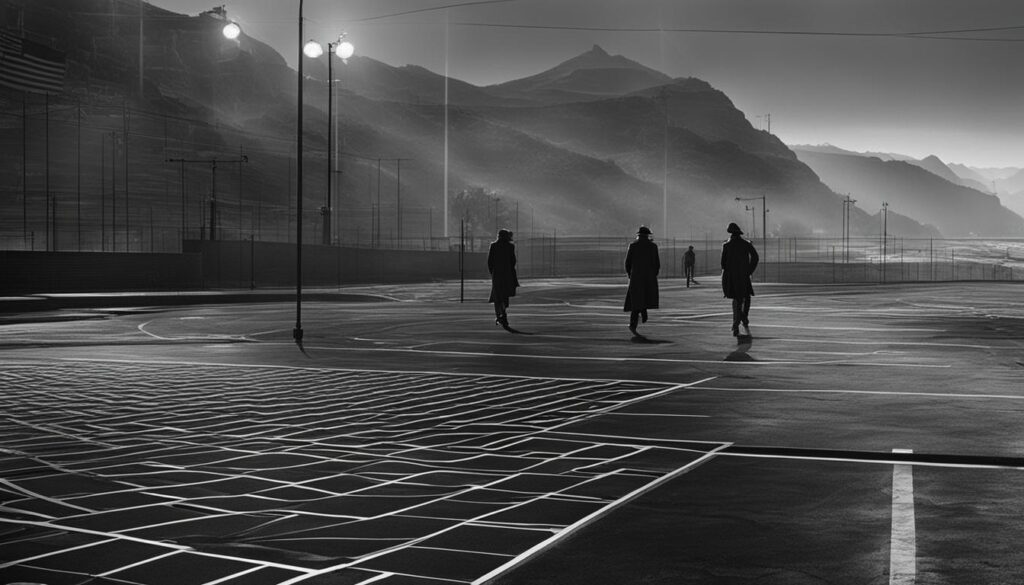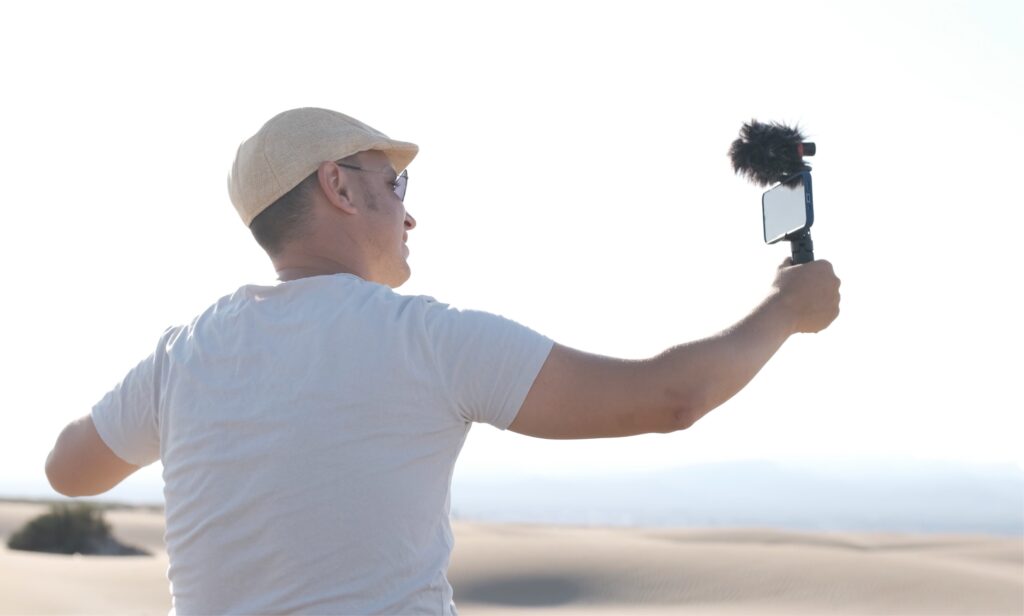The rule of thirds is a fundamental technique in video production, allowing videographers to create visually engaging and balanced shots that enhance the storytelling process. By mentally dividing the frame into equal vertical and horizontal thirds, videographers can strategically place points of interest on the gridlines and their intersections, resulting in aesthetically pleasing compositions.
Video composition, video framing, and videography techniques are crucial aspects of video cinematography and editing. Understanding the rule of thirds is essential for videographers to effectively communicate their intended message, create visual interest, and engage the audience on a deeper level.
Key Takeaways:
- The rule of thirds is a widely recognised composition technique in video production.
- By mentally dividing the frame into equal vertical and horizontal thirds, videographers can create visually pleasing and balanced shots.
- The rule of thirds enhances the storytelling process by strategically placing points of interest on the gridlines and their intersections.
- Video composition, video framing, and videography techniques play a significant role in video cinematography and editing.
- Understanding and applying the rule of thirds enhances the aesthetic appeal of videos and engages the audience on a deeper level.
Understanding the Rule of Thirds
The rule of thirds is a foundational composition technique used in videography, cinematography, and photography. This technique involves mentally dividing the frame into equal vertical and horizontal thirds, creating a grid. By placing points of interest on the gridlines and their intersections, videographers can achieve visually pleasing and balanced shots that enhance storytelling and engage the viewer’s eye.
The concept of the rule of thirds was first introduced by the 18th-century painter, John Thomas Smith. It has since become a fundamental principle in framing both moving and static images. Rather than placing the main subject in the center of the frame, this technique encourages videographers to position the subject off-center, resulting in a more natural and visually appealing composition.
By leveraging the rule of thirds, videographers can establish a dynamic relationship between the subject and the negative space within the frame. This allows for a more immersive and engaging visual experience, as the viewer’s attention is drawn to the subject’s interaction with the background. Whether capturing landscapes, portraits, or action sequences, understanding and applying the rule of thirds is essential for creating pleasing visuals and effective storytelling.
| Benefits of the Rule of Thirds | Examples |
|---|---|
|
|
Importance of the Rule of Thirds in Video Production
The rule of thirds is a fundamental composition technique in the world of visual art, including video production. It plays a crucial role in creating visually appealing and engaging videos that effectively tell a story and captivate the audience. By understanding and applying the rule of thirds, videographers can elevate their video compositions to a new level.
Visual storytelling is an essential aspect of video production, and the rule of thirds helps videographers effectively communicate their intended message. By placing the main subject or points of interest off-center, videographers create a visually dynamic composition that draws the viewer’s attention and creates visual interest. This technique allows for a more balanced and aesthetically pleasing shot, enhancing the overall impact of the video.
Moreover, the rule of thirds enables videographers to create visual depth and dimension within their videos. By aligning important elements along the gridlines and their intersections, videographers can guide the viewer’s gaze and create a sense of balance. This technique helps establish a visual hierarchy and leads the audience’s eye through the frame, enhancing the storytelling process and creating a more immersive watching experience.
The rule of thirds is an essential tool in video production that allows videographers to create visually appealing compositions, tell a story, and engage the audience. By placing key elements off-center and utilising the gridlines and intersections, videographers can create balanced shots that draw the viewer in and enhance the overall visual aesthetic.
| Benefits of the Rule of Thirds in Video Production |
|---|
|
Applying the Rule of Thirds in Film

The rule of thirds is a fundamental composition technique in film production that helps create visually engaging and balanced shots. By incorporating the rule of thirds, videographers can guide the viewer’s focus, enhance visual storytelling, and achieve a harmonious composition.
When applying the rule of thirds in film, it is crucial to consider camera angles and depth of field. By choosing the appropriate camera angle, videographers can emphasise certain elements within the frame and enhance the overall composition. For example, a low camera angle can convey a sense of power or dominance, while a high angle can create a feeling of vulnerability or insignificance. Depth of field also plays a vital role in utilising the rule of thirds effectively. By adjusting the focus on specific subjects or objects within the frame, videographers can draw attention to key elements and enhance the visual narrative.
Let’s take a closer look at how the rule of thirds can be applied in film production:
- Compose shots with the subject or points of interest placed along the gridlines or their intersections. This technique creates a visually balanced and aesthetically pleasing composition.
- Experiment with different camera angles and perspectives to create depth within the frame. This adds visual interest and enhances the storytelling.
- Consider the rule of thirds when framing moving subjects or capturing action scenes. While it may be challenging to align subjects precisely with the gridlines, keeping them off-center can still create a dynamic and engaging composition.
“The rule of thirds in film composition is like a guiding principle that allows us to create visually compelling and emotionally impactful scenes.”
Incorporating the rule of thirds in film production takes practice and experimentation. While it is essential to understand and apply this technique, it is also important to know when to break the rule for creative purposes. By understanding the fundamentals of the rule of thirds and exploring its flexibility, videographers can master the art of visual storytelling and create captivating films that resonate with the audience.
| Table: Examples of the Rule of Thirds in Film |
|---|
| Stanley Kubrick’s “The Shining” |
| “Lawrence of Arabia” |
| “2001: A Space Odyssey” |
| “Gone with the Wind” |
| “Pulp Fiction” |
Breaking the Rule of Thirds in Video Production
While the rule of thirds is a valuable guideline in video production, there are instances where breaking this rule can create a desired effect and enhance visual storytelling. One such scenario is in action scenes, where fast cuts and dynamic movements often make it challenging to align the subjects with the gridlines. By deviating from the rule of thirds, videographers can capture the intensity and energy of the scene, allowing the audience to feel fully immersed in the action.
Another situation in which breaking the rule of thirds can be effective is when showcasing large or overwhelming subjects. By centering the subject, videographers highlight its magnitude and create a sense of impact. This technique can be particularly powerful when capturing breathtaking landscapes, towering structures, or expansive cityscapes. The centered composition emphasises the scale and grandeur of the subject, evoking awe and wonder in the viewer.
Extreme close-ups are another instance where breaking the rule of thirds can be advantageous. When the subject fills the frame, centering it can intensify the viewer’s focus and draw attention to intricate details. This technique is often employed in emotional and intimate scenes, where capturing the subject’s facial expressions or subtle gestures is crucial for conveying powerful emotions and enhancing the narrative’s impact.
| Scenario | Break the Rule of Thirds | Effect |
|---|---|---|
| Action scenes | Align subjects with fast movements | Captures intensity and energy |
| Large subjects | Center the subject | Emphasises scale and impact |
| Extreme close-ups | Center the subject | Intensifies focus and highlights details |
Cinematic Example: Breaking the Rule of Thirds
“In the film ‘Gravity,’ director Alfonso Cuarón beautifully breaks the rule of thirds to immerse the audience in the vastness of space. By centering the characters against the backdrop of the star-filled expanse, Cuarón emphasises their isolation and vulnerability, creating a sense of awe and insignificance. This technique enhances the visual storytelling, as the centered composition reflects the characters’ struggle for survival in a hostile and unforgiving environment.”
Breaking the rule of thirds should be seen as a creative tool that empowers videographers to experiment and push the boundaries of visual storytelling. While the rule of thirds provides a solid foundation for composition, exceptional videos often arise when artists dare to deviate from the norm and create unique, arresting visuals that captivate and resonate with their audience.
Examples of the Rule of Thirds in Cinematography

Countless films utilise the rule of thirds in their cinematography, creating visually captivating and emotionally impactful scenes. In Stanley Kubrick’s “The Shining,” the rule of thirds is used to draw focus to Jack Nicholson’s intense facial expressions. By positioning Nicholson’s eyes along the upper horizontal gridline, Kubrick emphasises his character’s descent into madness. This placement adds to the suspense and psychological tension felt by the audience.
“All work and no play makes Jack a dull boy.”
In David Lean’s “Lawrence of Arabia,” the vastness of the desert landscape is emphasised by applying the rule of thirds. Shots of the characters riding across the open terrain are strategically positioned along the vertical gridlines, highlighting their small stature in contrast to the expansive surroundings. This composition technique enhances the sense of isolation and amplifies the grandeur of the environment.
Another example of the rule of thirds can be seen in Quentin Tarantino’s “Pulp Fiction.” During the iconic dance scene between Mia Wallace (Uma Thurman) and Vincent Vega (John Travolta), the placement of the characters’ heads along the upper horizontal gridline draws attention to their chemistry and connection. This compositional choice adds depth to their interaction and enhances the overall visual storytelling.
| Film | Director | Key Rule of Thirds Example |
|---|---|---|
| The Shining | Stanley Kubrick | Focus on Jack Nicholson’s facial expressions |
| Lawrence of Arabia | David Lean | Emphasising the vastness of the desert landscape |
| Pulp Fiction | Quentin Tarantino | Highlighting the chemistry between Mia Wallace and Vincent Vega |
These examples demonstrate how the rule of thirds can be effectively employed in cinematography to create visually engaging compositions and enhance storytelling. By placing key elements along the gridlines and their intersections, filmmakers can guide the viewer’s eye, convey emotions, and establish the visual rhythm of a scene. Incorporating the rule of thirds allows for a more aesthetically pleasing and balanced visual representation, ultimately elevating the overall cinematic experience.
Conclusion
The rule of thirds is a fundamental composition technique that holds great significance in video production. By understanding and implementing this rule, videographers can elevate the visual storytelling of their videos and engage the audience on a deeper level.
Through the rule of thirds, videographers can create visually appealing and balanced shots that enhance the aesthetic appeal of their videos. By placing the main subject or points of interest off-center, they can create a more natural and visually interesting composition. This technique allows for a dynamic interpretation of the subject’s relationship with the background and guides the viewer’s focus.
While it is important to learn and follow the rule of thirds, videographers should also feel empowered to break the rule when necessary. Certain scenarios, such as action scenes or showcasing large subjects, may call for deviations from the rule to create desired effects and enhance visual storytelling.
With the right tools and practice, videographers can master the art of video composition and create captivating visual narratives. The rule of thirds, in conjunction with other composition techniques, unlocks the potential for videographers to produce professional-quality films and captivate their audience with compelling visual storytelling.
FAQ
What is the rule of thirds in video production?
The rule of thirds is a widely recognised composition technique in videography, cinematography, and photography. It involves mentally dividing the frame into equal vertical and horizontal thirds and placing points of interest on the gridlines and their intersections.
Who coined the rule of thirds?
The rule of thirds was first coined by a painter named John Thomas Smith in the 18th century.
Why is the rule of thirds important in video production?
The rule of thirds is essential in video production as it enables videographers to effectively communicate their intended message, create visual interest, and engage the audience on a deeper level.
How can the rule of thirds be applied in film?
Using the rule of thirds in film requires considering how the subject moves across the frame, incorporating camera angles and depth of field. It helps guide the viewer’s focus and creates a sense of balance and harmony within the frame.
Are there exceptions to the rule of thirds in video production?
Yes, there are instances where breaking the rule of thirds can create a desired effect, such as in action scenes or when showcasing large or overwhelming subjects. The rule of thirds should be seen as a tool rather than a strict rule.
Can you give examples of the rule of thirds in cinematography?
Examples include films like “The Shining,” “Lawrence of Arabia,” “2001: A Space Odyssey,” “Gone with the Wind,” and “Pulp Fiction,” all showcasing the rule of thirds’ power in creating visually engaging compositions.
What is the significance of the rule of thirds in video production?
The rule of thirds is a powerful composition technique that plays a significant role in video production and visual storytelling. By understanding and applying this rule, videographers can enhance the aesthetic appeal of their videos, communicate their message effectively, and engage the audience on a deeper level.





